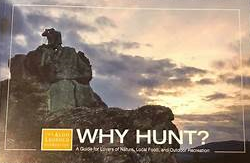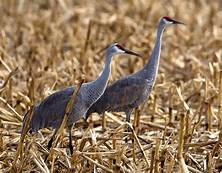 By Todd Schaller, WWA Vice President
By Todd Schaller, WWA Vice President
This article originally appeared in Wisconsin Waterfowl Association’s August, 2021 Newsletter edition.
Editor’s note: this article is Part IV in our series on exploring the issues surround a sustainable and ethical Sandhill Crane hunting season in Wisconsin. Part 1, Part II, Part III & Part IV were published in earlier editions of our newsletter.
A key topic worth exploring, related to a sustainable and ethical Sandhill Crane (SHC) hunting season, is also potentially one of the most difficult topics. Why hunt Sandhill Cranes?
 The reason an individual hunts in general, or hunts a deer, or a duck, or a species such as Sandhill Cranes in particular, is highly variable – connection to nature, sustainable food, to be with friends/family, etc. – but it is not the topic of this article. That topic is well-covered in the Aldo Leopold Foundation’s publication, “Why Hunt?”. It explores the ethical, cultural and practical reasons an individual may choose to hunt a species and is worth reading for both the hunter and the non-hunter.
The reason an individual hunts in general, or hunts a deer, or a duck, or a species such as Sandhill Cranes in particular, is highly variable – connection to nature, sustainable food, to be with friends/family, etc. – but it is not the topic of this article. That topic is well-covered in the Aldo Leopold Foundation’s publication, “Why Hunt?”. It explores the ethical, cultural and practical reasons an individual may choose to hunt a species and is worth reading for both the hunter and the non-hunter.
This article focuses on benefits the Sandhill Crane derives as a species as a result of its classification as a game animal at the federal level and in many states.
Sandhill Cranes were hunted within the United States until the early 1900’s. In a different era and time, one known reason for hunting cranes was commercial value related to food and clothing. We also know this commercial value and interest was one of the reasons for the decline of SHC population (along with other species) leading to strict regulation prohibiting SHC hunting around 1916.
Thankfully, the hunting community – and society as a whole – started to understand the importance of science, conservation, habitat protection, game regulations and balance of nature through the teaching, actions and writings of John Muir, George Bird Grinnell, Aldo Leopold, Rachel Carson, Theodore Roosevelt and others.
This change in thinking resulted in wildlife management milestones like:
- The Migratory Bird Treaty Act that recognized the international aspects of waterfowl and other migratory birds,
- The Federal Waterfowl Stamp funding that puts more habitat under governmental protections,
- The Pittman-Robertson Federal Aid in Wildlife Restoration Act that levies an excise tax on the gear used by sportsmen and women to fund habitat and wildlife management activities throughout the country,
- State Licensing/Stamp systems required to take game that fund the habitat needed by those species.
 And through steps like these, the North American Model of Wildlife Conservation was gradually developed.
And through steps like these, the North American Model of Wildlife Conservation was gradually developed.
This series of milestones collectively lead to the recovery of several previously hunted migratory species, including the Sandhill Crane. In his Marshland Elegy, Aldo Leopold lamented the habitat loss he foresaw as leading to the demise of the Sandhill Crane. He did not live to see its remarkable rebound, resulting from the actions noted above. The population recovered to the point a hunting season was re-established in 1961 on the Mid-Continent Population of Sandhill Cranes. Through science and proper management, SHC hunting opportunity is increasing within the United States today.
The North American Model of Wildlife Conservation has become the management cornerstone used by federal and state agencies – it is described by seven key principles. This model directly describes how hunting management today has changed from a century ago.
- Wildlife is a public resource
- Governments have a role in managing the resource on behalf of all citizens and to ensure the long-term sustainability of wildlife populations.
- Markets for game are eliminated
- Recognizes the devastating impacts of commercialization of the resources which lead to decimated populations of many species in early 1900s
- Allocation of wildlife law
- Importance of regulations such as seasons, bag limits, license etc.
- Wildlife can only be killed for a legitimate purpose
- Wildlife is a shared resource not to be wasted or killed for frivolous reasons.
- Wildlife Species are considered an international resource
- Recognition of wildlife movement and specifically migrations
- Science is the proper tool for discharge of wildlife policy
- Importance of science-based (biological and social) decisions.
- Democracy of hunting
- Access to wildlife in keeping with democratic principles and not based on wealth, prestige or land ownership.
It seems this history changes the question from, “Why hunt SHC?”, to “What conservation benefit derives from SHC hunting?” While hunting does include the taking of individual animals (which some will always adamantly oppose), recent history has demonstrated the positive aspect of hunting which can and would benefit SHC at the species level.
Since the market hunting and dust bowl eras when waterfowl were in decline, a system of continental waterfowl management in the face of changing conditions has been developed and implemented to continue the recovery of waterfowl species. This includes:
- A proven model of cooperative international councils taking shared decisions, informed by science, and largely funded by waterfowlers; continental, landscape, and local habitat management efforts largely funded by waterfowlers; and annual population surveys driving regulatory guidelines.
- Increased interest, awareness and attention to SHC by a passionate group of conservation minded individuals and organizations.
- Increased resources to SHC through state funding and more funding opportunities based on federal programs like Pittman-Robertson.
It may not be fully appreciated by society at large, but today’s hunters are stewards of the land and the species they pursue. They demonstrate a special interest, connection and commitment to conservation and protection that benefit those species, and which counters other debilitating societal pressures on those species.
